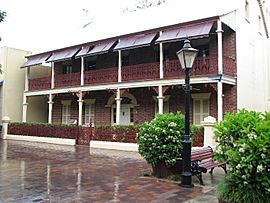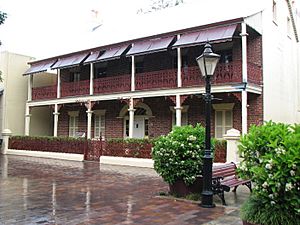Loder House facts for kids
Quick facts for kids Loder House |
|
|---|---|
 |
|
| Alternative names |
|
| General information | |
| Status | Hawkesbury Remakery |
| Type | Town house residence, bank, restaurant, guest house, residence |
| Architectural style | Australian Georgian |
| Location | 126-128 George Street, Windsor, Sydney, New South Wales |
| Country | Australia |
| Coordinates | 33°36′22″S 150°49′20″E / 33.6061826343°S 150.8221850920°E |
| Completed | 1834 |
| Client | George Loder |
| Official name: Loder House | |
| Type: | Built |
| Criteria: | a., b., c., d., e., f., g. |
| Designated: | 2 April 1999 |
| Reference #: | 00003 |
Loder House is a very old and special building located at 126 George Street in Windsor, City of Hawkesbury, New South Wales, Australia. It was built way back in 1834. Over the years, it has been used for many different things. It was once a bank, several restaurants, a guesthouse, and even a bookshop! Because it's so important to history, it was added to the New South Wales State Heritage Register on 2 April 1999.
Contents
Discover Loder House
A Look Back in Time
First People of the Land
Long before European settlers arrived, the lower Hawkesbury area was home to the Dharug people. This region, especially near the Nepean River and South Creek, was a key place for them to find food. The Dharug and Darkinjung people called the river Deerubbin. It was a super important source of food and a way to travel for them.
European Settlers Arrive
In 1789, Governor Arthur Phillip explored this area. He was looking for good land to farm. He found and named the Hawkesbury River after Baron Hawkesbury. This region became very important for the early growth of the colony. European settlers started living here by 1794.
The area, first called Green Hills, was known for its rich farmland. It helped feed the colony during tough times. But the river often flooded, which could ruin the farmers' crops and homes.
The land where Loder House stands was first given to a European in 1794. Francis Grose granted thirty acres to Samuel Wilcox. He named it Wilcox Farm. It's likely that farming and some building happened here during this early time. Later, Wilcox Farm became part of a much bigger farm called Peninsula Farm.
In 1810, Lachlan Macquarie became the new Governor of New South Wales. Under his leadership, the colony grew stronger. Macquarie had a big plan for the colony. He started many public building projects, creating 265 new buildings. He also improved roads and other services. The Hawkesbury district really thrived under him. In December 1810, Macquarie named five new towns in the Hawkesbury area. These are known as the Macquarie Towns. After this, Windsor became a more settled town with streets and public buildings.
The Story of Loder House
Loder House was built in 1834 for George Loder Jnr. He was a successful farmer and merchant. George Jnr.'s father was a soldier who came to Australia from India. In 1819, George Jnr. married Mary Ann Howe. They were very good at farming. They decided to move to Windsor town and open a butcher's shop. Soon after starting their business, they began building a large townhouse. They built Loder House on the main street of Windsor. It was meant to be a home for their big, young family.
George Jnr. also went on explorations with his father and younger brother. They explored the Hunter District and discovered the Singleton area. They also received land grants there.
Sadly, George Loder Jnr. died in 1834, at only 38 years old. He never got to live in his grand new house. He was buried in the family vault at St Matthew's Anglican Church. He left the house to his wife, Mary Ann, and his younger brother.
In 1835, Mary Ann married her brother-in-law, Thomas Dargin II. He also had a large family. Together, they moved into the house on George Street. It became known as Loder's House. Thomas Dargin died in 1843. Mary Ann married again in 1846 to Laban White. He was an auctioneer and an important person in Windsor. They continued to live in Loder House until White died in 1873. After that, Mary Ann moved to live with relatives in Singleton. She passed away in 1882.
After Mary Ann left, the house became a branch of the Commercial Bank of New South Wales. This was from 1874 to 1889. The upstairs and back parts of the house were used as a home for the bank manager. In 1889, Benjamin Richards bought the building. It became a family home again. In 1893, Richards sold the property to Daniel Holland. He was another successful merchant in the town. He and his family lived there for several years. They added the beautiful cast iron lacework and stone wall. These replaced an older wooden fence. Holland ran a successful clothing business in Windsor. He eventually left the area in 1906.
From 1923 to 1940, Reginald Wilbow used the building as a boarding house.
In 1973, the building was partly damaged by fire. Then, a company called Pacific Investments bought it. They wanted to knock down the building and build a modern office block. But many people strongly disagreed with this plan. So, the Department of Planning and Environment bought the property in 1975. They wanted to make sure the historic building was saved.
Loder House has been connected to many important local families. These include the Loder, Dargin, White, Richards, and Holland families.
The building was repaired with help from a special grant. Architects Fisher Lucas worked on the restoration. Then, it was leased to the Hawkesbury Shire Council. In 1978, a Permanent Conservation Order was placed on the property. This meant it was protected by law. This order covered the land, the house, a brick outbuilding, and the boundary fence. It was only the third such order made in New South Wales under the Heritage Act 1977.
Since the government bought it, the building has been used for many things. These include restaurants like "Lachlan's Restaurant" and "Governor's Choice." It was also a boarding house and a bookshop for many years. It was sold in November 2006. In August 2017, it was empty and available for rent.
What Loder House Looks Like
Loder House is a two-storey brick townhouse built in 1834. It's in the Georgian style, which was popular at the time. It also has an attic. Later, a two-storey wooden verandah was added. This verandah has pretty cast iron lacework on its balustrades and decorative brackets.
The top floor has five French Doors that open onto the verandah. These doors are placed evenly across the front. They have stone voussoirs (wedge-shaped stones above an arch). On the ground floor, there are pairs of windows with stone voussoirs and sills. A main entrance is in the middle, with an arched fanlight above it.
The front of the house is made of original sandstock bricks. The side walls have been covered with a smooth finish. In 1975, a report said the street front was covered in stucco. The rest of the outside walls were exposed brick.
The corrugated iron roof was replaced when the building was restored. The verandah floor is made of stone flags.
In the grounds, there's a boundary wall from the 1830s. There's also an unusual square outbuilding. This building dates back to when Loder House was first built. Some old stone flagging can still be seen in the back yard.
Today, the townhouse faces the Windsor pedestrian mall. The building seems to be in great shape. It was restored in 1975. The land around the house might hold interesting archaeological finds. This is especially true near the outbuilding, whose original purpose isn't clear. The house is mostly still as it was built, even though it almost burned down.
Why Loder House is Special
Loder House is a rare and well-preserved two-storey brick Georgian townhouse. It stands on the main street of Windsor. The building has been linked to many important local people. These include the Loder, Dargin, White, Richards, and Holland families. The house grounds have an old boundary wall from the 1830s. There's also a unique square outbuilding from the time the house was built.
Loder House was added to the New South Wales State Heritage Register on 2 April 1999. It met several important requirements:
- It shows how New South Wales's history developed.
Loder House is very important for its connection to the Loder Family. They were an early, important family in Windsor. It also shows how the town of Windsor grew, both as a place to live and for businesses.
- It has a strong link to important people or groups in New South Wales's history.
The building has been connected to many important local people. These include members of the Loder, Dargin, White, Richards, and Holland families.
- It shows great beauty or amazing design in New South Wales.
Loder House is very beautiful and important as a rare Georgian townhouse. It's one of the few such houses still standing in Windsor. It adds a lot to the look of Windsor's main street.
- It has a strong link to a community or group for social, cultural, or spiritual reasons.
Loder House is socially important because of its connection to an early, important Windsor family. Also, its use as a bank in the mid-1800s makes it socially significant.
- It can help us learn more about New South Wales's history.
Loder House is important for research. It shows building methods from the early 1800s. It also helps us understand what daily life was like back then.
- It is uncommon, rare, or endangered in New South Wales.
Very few large Georgian townhouses still exist in the Sydney region. Loder House is one of the most complete ones.
- It shows the main features of a type of historic place.
Loder House represents how the first towns beyond Sydney and Parramatta developed. These were called the 'Macquarie Towns'.




